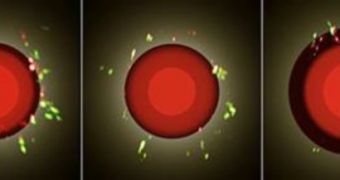Astronomers succeeded in dissecting a pulsating red giant star, S Orionis, to examine the layers of dust and gas. This star has a pulse period of 410 days, during which it changes in volume, from one equal to the orbit of Mars to one equal to the orbit of Jupiter.
S Orionis is a red giant star in the constellation Orion. It is a Mira variable, a class of pulsating variable stars characterized by very red colors, pulsation periods longer than 100 days and light amplitudes greater than one magnitude.
Red stars are in the very late stages of their evolution and pulsate due to the entire star expanding and contracting, which produces a change in temperature along with radius, both of which factors cause the variation in luminosity.
Our own star will reach this stage of evolution in about 5 billion years, according to astronomer David Boboltz of the U.S. Naval Observatory. This is the first time astronomers have used the largest telescopes available to study the layers of such a star.
"No study of a red giant has been done to this level, looking at infrared and radio-wave views simultaneously," Boboltz said. "This really show us where the layers are. A lot of material escapes from the star's gravity, and begins to form beautiful planetary nebulas."
"But gravity overcomes a lot of gas and dust that gets pulled back into the star, starting the cycle all over again and forming a kind of pulse."
The team measured the layers of dust and gas around the star and found that the star's dusty shell of corundum-a compound used in sandpaper-was twice as large as previously thought. They also proved that this corundum mixes with gaseous silicon monoxide, a compound astrophysicists thought existed as a dust outside of red giants.
"We've essentially mapped the envelopes of material around these stars, which has never really been done before," Boboltz said. "We also hope to explain how a planetary nebula forms from a red giant near the end of its life as a white dwarf star."

 14 DAY TRIAL //
14 DAY TRIAL //